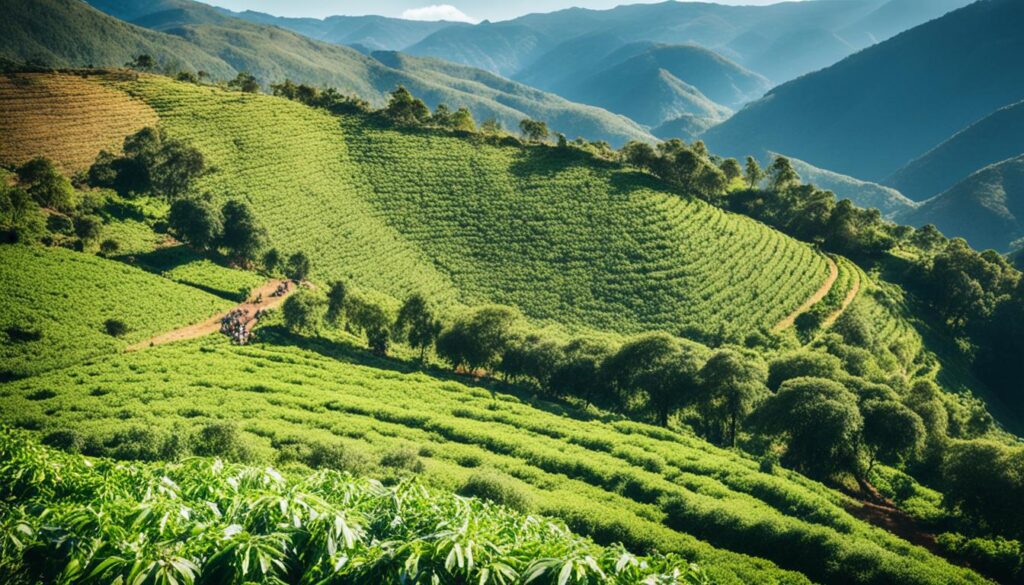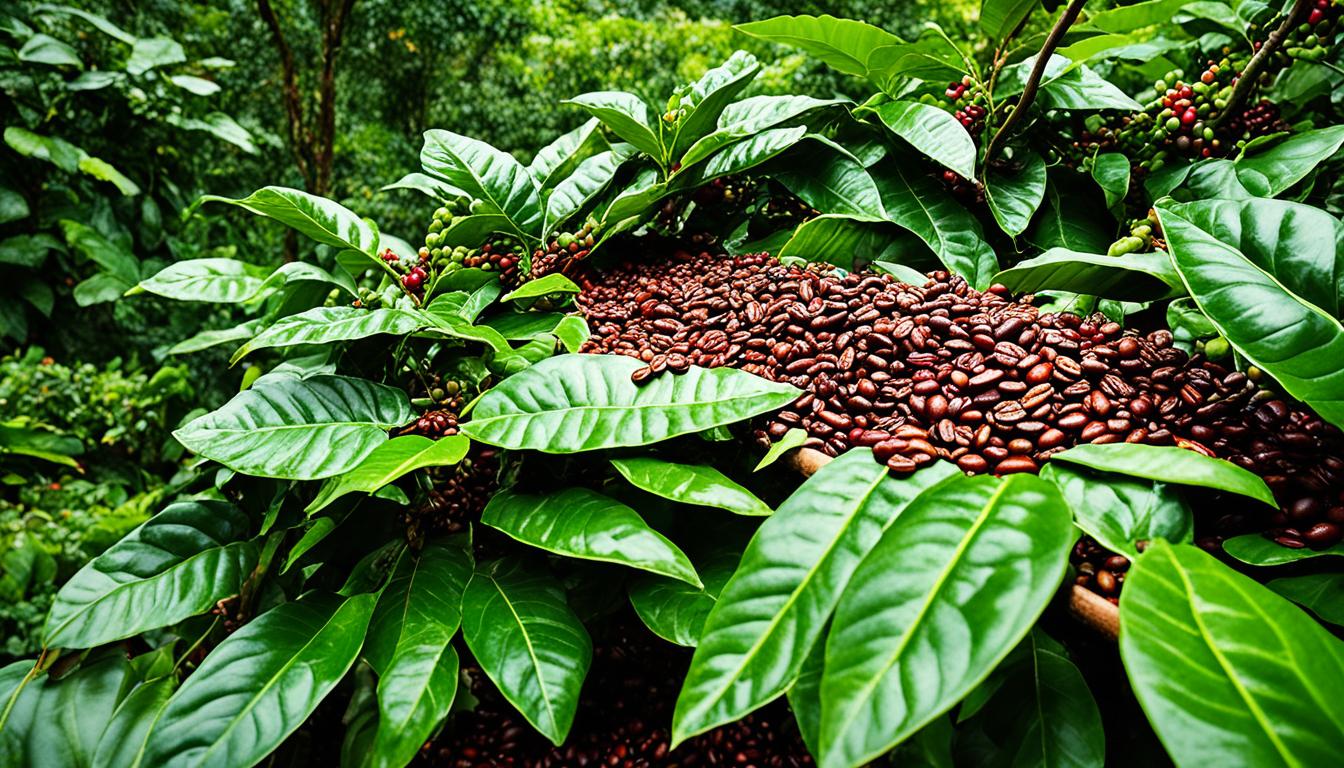Is Coffee From Ethiopia?
Yes, you heard it right! The birthplace of everyone’s favorite caffeinated beverage is none other than Ethiopia. This East African country has a long and fascinating history with coffee, dating back centuries. But how did coffee make its way from Ethiopia to becoming one of the most consumed beverages in the world?
Legend has it that a goat herder named Kaldi discovered coffee’s potential when he noticed his goats becoming energetic after eating the berries from a certain tree. He shared his findings with the local monks, who brewed a drink with the berries and found it kept them awake during evening prayers. And thus, the love affair with coffee began.
Key Takeaways:
- Ethiopia is the birthplace of coffee, with a history dating back centuries.
- A goat herder named Kaldi is said to have discovered the energizing effects of coffee.
- The drink made its way to Europe and the Americas, where it gained popularity.
- Today, Ethiopia remains an important coffee producer with a rich coffee culture.
- Millions of people rely on coffee production for their livelihoods in Ethiopia.
Ethiopian Coffee Industry: Production and Regions
Ethiopia holds a prominent position in the global coffee market, contributing approximately 17% of its total production. The Ethiopian coffee industry plays a crucial role in the country’s economy, serving as a significant source of foreign income through coffee exports. Supported by over 4 million small-scale farmers, Ethiopia’s coffee production is a cornerstone of its agricultural sector.
The country boasts diverse coffee growing regions, each with its own distinct flavor profiles. The prominent regions include:
- Sidamo: Known for its excellent quality coffee beans, Sidamo produces beans with floral and fruity flavors, often associated with wine-like notes.
- Yirgacheffe: Famed for its delicate and vibrant coffee, Yirgacheffe offers a floral aroma, citrusy acidity, and a clean finish.
- Harrar: Recognized for its distinctively bold and fruity flavors, Harrar coffee showcases rich wine-like characteristics, with a hint of blueberry undertones.
Ethiopian coffee cultivation can be differentiated into three main types:
- Forest Coffees: Grown in the lush wilderness of the Ethiopian highlands, these coffee beans thrive in their natural habitat, absorbing the unique flavors of the surrounding flora.
- Garden Coffees: Cultivated in the vicinity of residential areas, garden coffees develop their flavor nuances from the trees and plants surrounding these dwellings.
- Plantation Coffees: These coffee beans are grown on larger farms with organized cultivation practices, supplying the global market with coffee on a larger scale.
The exact size of coffee cultivation in Ethiopia remains difficult to determine due to the fragmented nature of coffee farms. However, it is estimated that millions of Ethiopians rely on coffee production for their livelihoods, reflecting the deep-rooted significance of coffee in Ethiopian culture and society.
“Ethiopia’s coffee industry thrives on the dedication of small-scale farmers, cultivating distinct coffee beans in diverse regions, which continue to captivate coffee connoisseurs worldwide.”
To illustrate the significance of Ethiopian coffee production, we present the following table showcasing the top global coffee producers.
| Rank | Country | Percentage of Global Coffee Production |
|---|---|---|
| 1 | Brazil | 40% |
| 2 | Vietnam | 18% |
| 3 | Colombia | 6% |
| 4 | Indonesia | 6% |
| 5 | Ethiopia | 5% |
As depicted in the table, Ethiopia ranks fifth in global coffee production, underlining its significance in the coffee industry. This achievement is a testament to the rich coffee culture and thriving coffee industry that Ethiopia has cultivated over centuries.
The Ethiopian Coffee Industry: Politics and Challenges

The Ethiopian coffee industry has played a vital role in the country’s economy for centuries. However, it has faced numerous political and economic challenges throughout its history.
From 1974 to 1991, the government consolidated coffee farms into large, collective farms. During this time, farmers were required to sell their coffee at a subsidized price to the government. This centralized approach aimed to control the coffee market and distribute resources more evenly.
After 1991, the government allowed farmers to form cooperatives and set fair prices for their coffee. This change gave farmers more autonomy and allowed them to negotiate better deals for their products.
In 2008, the Ethiopia Commodity Exchange (ECX) was established to ensure efficient trade of crops, including coffee. The ECX aimed to standardize coffee quality and raise prices for coffee growers.
The ECX has led to more consistent coffee quality and increased prices for our coffee. However, it has also made it challenging to trace the origin of coffee purchased from the exchange.
Coffee farming is a major source of income for many Ethiopians, supporting millions of livelihoods. However, the government is making efforts to reduce the industry’s share of the GDP by promoting the growth of the manufacturing sector.
Challenges in the Ethiopian Coffee Industry:
- Limited traceability due to the Ethiopia Commodity Exchange (ECX) system
- Economic dependency on coffee farming
- Political policies affecting coffee farming and trade
- Competition with other coffee-producing countries
Despite these challenges, Ethiopian coffee farmers continue to thrive, producing high-quality beans that are sought after worldwide.
Ethiopian Coffee: Varieties and Flavor Profile

Ethiopian coffee is renowned for its wide variety of flavors and distinct taste profiles. With over a thousand varieties of coffee beans grown in the country, the indigenous arabica variety stands out as the most popular and highly sought-after.
Ethiopian coffee beans can be categorized into three main varieties:
- Longberry: These beans are long in shape and offer a delicate, floral flavor profile. They are known for their bright acidity and notes of citrus and jasmine.
- Shortberry: Shortberry beans are smaller in size and tend to have a sweeter, fruity taste. They often exhibit flavors of berries, stone fruit, and chocolate.
- Mocha: Mocha beans are smaller and rounder, with a rich and complex flavor profile. They are known for their deep, earthy tastes, often with hints of spice and wine-like undertones.
The flavor profile of Ethiopian coffee is further influenced by the different growing regions. For example:
- Sidamo: Coffee from the Sidamo region features a medium body and bright acidity. It is known for its floral aroma and flavors of citrus, black tea, and wine.
- Yirgacheffe: Yirgacheffe coffee has a smooth and clean cup, with a delicate body and vibrant acidity. It offers a wide range of flavors, including floral notes, tropical fruits, and hints of chocolate and spice.
- Harrar: Harrar coffee is bold and full-bodied, with a distinctive fruity and wine-like flavor profile. It often exhibits complex flavors of blueberry, cherry, and dark chocolate.
The processing methods used for Ethiopian coffee also contribute to its unique flavor profile. The dry or natural process involves drying the coffee cherries with the beans inside, resulting in a fruitier and sweeter taste. On the other hand, the washed process involves removing the cherry pulp before drying, leading to a cleaner and brighter cup.
Overall, Ethiopian coffee offers a sensory experience like no other, with its diverse flavors, varieties, and regional characteristics. Whether you prefer a light and fruity cup or a deep and earthy brew, Ethiopian coffee brands and their beans are sure to satisfy your taste buds.
Conclusion
Coffee from Ethiopia is a gem among the world’s coffee offerings. With a vast array of coffee beans, Ethiopian coffee farming has a deep-rooted history and a leading position in the global coffee industry. The aromatic and exquisite ethiopia coffee beans are cultivated by small-scale farmers who take great pride in their craft, contributing to the country’s rich coffee culture.
The Ethiopian coffee industry is a vital component of the nation’s economy, providing income and support to millions. The coffee-growing regions of Ethiopia, including Sidamo, Yirgacheffe, and Harrar, offer distinct flavor profiles that captivate coffee enthusiasts. From the fruity and nuanced notes of Yirgacheffe to the bold and complex flavors of Sidamo, each cup of Ethiopian coffee tells a unique story.
The tradition of ethiopian coffee farming is fortified by the expertise and dedication of farmers, resulting in an exceptional taste that is sought after by coffee lovers worldwide. The coffee cherries undergo meticulous processing methods, such as the dry or natural process, which highlight the beans’ natural flavors. When enjoying Ethiopian coffee, one embarks on a sensory journey, savoring the invigorating aromas and diverse tastes that exemplify the country’s coffee prowess.




